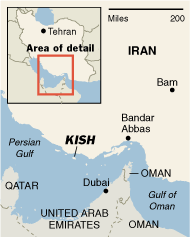KISH, Iran — The indoor dolphin show was in full swing as Hossein Sabet walked in to a burst of applause from the 1,200 people in attendance. Clad in tight beige equestrian pants and tall black boots, he waved at the crowd and went straight to his office behind the pool.
 Tourists at the hotel, which incorporates replicas of ancient landmarks that symbolize Persia at the zenith of its power.
Tourists at the hotel, which incorporates replicas of ancient landmarks that symbolize Persia at the zenith of its power.
Kish is accessible to foreigners who do not have a visa.
Mr. Sabet, 58, an Iranian who spends most of his time in Germany, is no performer, however. He is a businessman and something of a local legend, having invested more than $300 million here in hotels and attractions like the dolphin show, the only one in the Middle East.
He has built this island’s fanciest establishment, the Dariush Grand Hotel, modeled after the Persian capital of Persepolis, which dates from 500 B.C. He also owns 11 hotels in Europe and the Canary Islands.
One of Iran’s islands on the Persian Gulf, Kish is accessible to foreigners without visas and to Iranians looking to vacation in a relatively relaxed atmosphere, though things are not as relaxed now as they were before President Mahmoud Ahmadinejad came to power.
In addition to the Dariush Grand — named for Darius the Great, the sixth-century B.C. empire builder who was eventually defeated by the Greeks at Marathon — Mr. Sabet owns five hotels here and a huge park with exotic birds, an aquarium, a butterfly enclave and the dolphin show.
He says he is also negotiating to build the Middle East’s first Disneyland, but his passion is Iran and its Persian identity. “I have reached a point in life that money does not matter anymore,” he said in an interview at the Dariush Grand. “I want to make people happy. I want to revive the 7,000-year-old identity of this nation.”
Mr. Sabet, an engineer by training, is good-humored, energetic and fit. He constantly recites Persian poetry, and speaks Persian with the strong accent of Mashad, the northeastern city where he was born and lived until the age of 21. He rides his black Arabian horse every afternoon at dusk on the beach during the 10 days that he spends on the island every month.
More Las Vegas than Disneyland, his Dariush Grand looks like an ancient palace and incorporates replicas of ancient landmarks that symbolize Persia at the zenith of its wealth and power (when it dominated an area that extended from contemporary Afghanistan and India in the east to Egypt and Greece in the west).
There are reproductions of artifacts from Persepolis, statues of bulls, lions, griffins and human-headed bulls in every corner. The lotus flower, the symbol of life and endurance, is carved on the floors, in the garden and on the furniture and doors.
The entrance to the hotel is copied after the Gate of all Nations at Persepolis, flanked by two soldiers followed by two creatures that have the body of a lion, the wings of an eagle, the legs of a bull and the head of a human. The stairs in the garden are modeled after the ones at Persepolis — gradual and wide — to allow people to walk slowly and with dignity.
“You are a brave man and thank you for reminding us of our past,” wrote one guest at the memorial notebook of the hotel who introduced himself only as a university professor. About 57 thick notebooks have been filled in a year with similar messages.
Religious authorities have shown no interest in the country’s pre-Islamic heritage. A prominent revolutionary cleric even suggested bulldozing the last ruins of Persepolis in the early days of the Islamic Revolution.
But now even religious conservatives are finding ways to reconcile with their country’s past. Ehsan Bonakdar, 25, with his conservative wife wrapped in a head-to-toe black chador, complained to the concierge at the Grand Dariush that he was disappointed that there were not enough symbols of Persepolis in his room. “This hotel tells the world who we were,” Mr. Bonakdar said. “We are reaching that point again, we are becoming powerful under this government,” he added, alluding to Mr. Ahmadinejad’s insistence on moving ahead with the country’s nuclear program.
Mr. Sabet’s 18 Ukrainian dolphins have become the island’s darlings. They perform with Persian dance music, even though dance music was declared un-Islamic, and illegal, after the 1979 Islamic Revolution. It is produced only by Iranian expatriates in Los Angeles, and Kish is the only place in Iran where it is heard.
Islamic law, it seems, was powerless before the charms of the dolphins. “Even local authorities love them,” said an employee, who spoke on condition of anonymity for fear of losing his job. “The island’s cleric comes and visits them every week to make sure they are O.K. He keeps complaining that the music is not jolly enough and they might get depressed.”
Iran, which confiscated the assets of many businessmen after the revolution and has interfered in the private sector ever since, is considered a high-risk country for investors. In fact, Iran suffers from capital flight. In that light, “He is among the very few who have invested here,” Saeed Leylaz, an economist in Tehran, said of Mr. Sabet. But he said the investment had paid off handsomely. “I believe he started making money much faster than he could anywhere else in the world.”
Mr. Sabet concedes that business has been good in Kish, even better than at his hotels on the Canary Islands. Rooms at the Dariush Grand run from $180 to $680 for the royal suites and are seldom empty.
His next project is to pay tribute to the 10th-century poet Ferdowsi, who wrote the epic poem “Shahnameh,” whose name means epic of kings. As part of that he wants to build a hotel, university and library near Ferdowsi’s tomb in the northeastern city of Toos.
“We spoke Arabic for 200 years, and this man saved our Persian language by locking himself up for over 30 years to write the epics without a word of Arabic,” he said about Ferdowsi, who revived the Persian language after the Arab conquest of Persia in the seventh century.
“How can you lift these?” he asked, pointing to huge rocks mounted high on the walls, with scenes from Persepolis carved into them. Each one, he said, weighs almost 18 tons. “Only with love and devotion,” he said. “That’s how I have worked here.”
